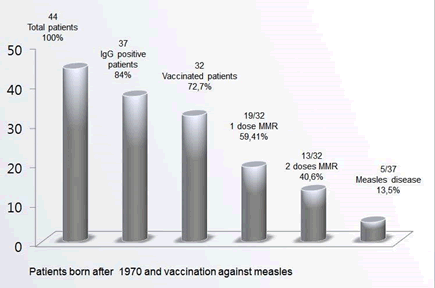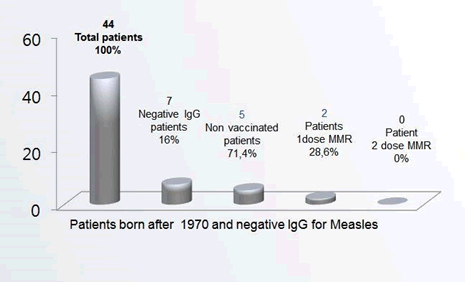Research Article - (2022) Volume 8, Issue 3
Seroprevalence for Measles Antibodies among Multi-Transfused Patients with Hemoglobinopathies: The Experience of a Thalassemia and
Sickle Cell Department in Greece
Manganas Konstantinos1*,
Sophia Delicou1,
Myria Pougiouka2,
Aikaterini Xydaki1,
Maria Liosi2,
Denis Gubbini2 and
Vasiliki Skandami2
1Thalassemia and Sickle Cell Department, Hippocratio General Hospital, Greece
2Microbiology Laboratory, Hippocratio General Hospital, Greece
*Correspondence:
Manganas Konstantinos, Thalassemia and Sickle Cell Department, Hippocratio General Hospital,
Greece,
Email:
Received: 16-May-2022, Manuscript No. IPJPIC-22-13443 ;
Editor assigned: 18-May-2022, Pre QC No. IPJPIC-22-13443 (PQ);
Reviewed: 01-Jun-2022, QC No. IPJPIC-22-13443 ;
Revised: 06-Jun-2022, Manuscript No. IPJPIC-22-13443 (R);
Published:
13-Jun-2022, DOI: 10.36648/2471-9668.21.8.90
Abstract
Background: Infections are frequent in patients with hemoglobinopathies and in recent years have become a
significant cause of morbidity and mortality in this group of patients.
Aims: The purpose of this study was to determine the immunity status to measles of patients with hemoglobinopathies
due to the recent revival of measles in Greece.
Methods: 75 multi-transfused patients were studied. Serum measles IgG antibody titers were measured by an
Enzyme linked immunosorbent assay to determine the measles immune status and document previous measles
infection in individuals without a prior history of immunization.
Results: All but one of the 31 patients who were born before 1970, date of the introduction of nationwide
vaccination, was antibody positive. Of the younger patients, 84% were antibody positive and 7 (6%) negative: of
this group 72.7% had been vaccinated during childhood, while 11.8% had suffered measles. Of the vaccinated patients,
40.6% had received 2 doses of the vaccine while 59.4% received one. Of the non-immune patients 71.4%
had not been vaccinated and the other two had been vaccinated with one dose of the vaccine. All were offered
vaccination: 57.1% accepted and developed antibodies after one dose, while three refused.
Conclusion: Measles seropositivity was uniformly high among patients with hemoglobinopathies. Nearly both
subgroups had evidence of measles seropositivity levels greater than the estimated threshold necessary to sustain
measles elimination.
Keywords
Measles; Vaccinations; Hemoglobinopathies; Humoral immunity
Description
Infections are important cause of death in patients with hemoglobinopathies,
on account of multiple transfusions, secondary
hemochromatosis and iron overload, splenectomy, cellular and
humoral immune deficiencies [1]. In such patients vaccination is
necessary for the protection of from a potentially fatal infection
like measles.
The recent measles outbreaks in Europe during the period 2016-2018 and the several deaths of people with underlying disease,
challenged us to estimate the present prevalence of measles immunity
among our patients with hemoglobinopathies by determining
seroprevalence of IgG antibodies against measles.
Materials and Methods
75 multi-transfused patients with hemoglobinopathies followed
at our department were studied, 52 with β-thalassemia and 23
with sickle cell disease; they fell into two groups according to
their birth date, those born before 1970 (n=31, median age: 56
years, range: 51-69 years old) and after 1970 (n=44, median age:
46 years, range: 21-50 years old). This classification was according
to the National Immunization Programs [2], because the measles
vaccine was released in Greece after 1970 and only those
who had experienced measles had already acquired natural immunity.
The determination of IgG antibodies to measles was done by an
Enzyme linked immunosorbent assay [3]; the sensitivity of the
method is >99% and the specificity is 95%. The result is considered
negative for measles immunity when IgG antibodies are less
than 150 mIU/mL and positive when they are at levels >200 mIU/
mL.
Results
Out of the 31 patients who were born before 1970, all but 1 (96.7%) turned out to be immune. Of these, 8 had been vaccinated
during adulthood.
Out of the 44 patients born after 1970, 37 (84%) were immune
and 7 (6%) not; of the 37 immune ones, 5 (11.8%) had experienced
measles and 32 (72.7%) had been vaccinated during childhood,
with 2 doses in 13 patients (40.6%) and one dose in 19
(59.4%).
Of the 7 non immune patients born after 1970, 5 (71.4%) had not
been vaccinate at all and the other two had been inoculated with
one dose only; vaccination was recommended and offered to all
8 patients. 5 of them (62.5%) accepted and developed antibodies
after one vaccine dose, while three refused vaccination.
Antibody titers were high in 41/67 (61%) of the immune patients,
possibly indicating coexisting passive immunization from transfusions.
Discussion
When the Morbillivirus entered a non-immunized, naive, population,
90%-100% of individuals develops the clinical symptoms
of measles and acquires a lifelong immunity. After the introduction
of compulsory vaccination, most incidents in the developed
countries concerned the few non immune persons, who had escaped
measles or had not been vaccinated properly.
In Greece, the measles vaccine was introduced in the 1970’s, followed
by the systematic application of the MMR vaccine from
1989, according to the compulsory National Immunization Programs.
This led to a substantial reduction of measles incidence
in the following years [4]. The next measles epidemic in Greece
occurred in 1996 and from then since the autumn of 2005 there
had been no recorded cases of measles [5]. More than 20,000
incidents across Europe (30 EU/EEA Member States) and 79
deaths (31 of which in 2018) have been recorded during the period
2016-2018. From May of 2017 until June of 2018, 3278 new
cases of measles have been recorded in Greece, with a higher
incidence in southern Greece and almost two-thirds of reported cases belonged to the Roma population [6].
In the present study, most patients born before 1970 (23 out of
31%-74.1%) seem to have naturally acquired humoral immunity
and 8 more (23.9%) have an artificially acquired immunity, as
they had been vaccinated as adults.
In the current study, 32 of the 44 (72.7%) patients born after
1970 had been vaccinated during childhood: of these 32 vaccinated
patients, two doses were administered to 13 (40.6%) and
one dose to 19 (59.4%).
We found no measles antibodies in 7 patients born after 1970;
of these, 5 (71.4%) had not been vaccinated, while two had received
a single vaccine dose but did not develop antibodies due
to conditions that caused them severe immunosuppression, as
one patient suffered from chronic kidney disease and the other
from diabetes mellitus with poor glycemic control [7]. Vaccination
was recommended and offered to all 8 patients. 5 (62.5%)
accepted and developed antibodies after one vaccination dose,
while three refused vaccination due to social assertions (anti-vaccination
movement) (Figures 1 and 2) [8]. Finally, during the
measles epidemic, none of the patients became ill, or anyone
from their contacts [9,10].

Figure 1: Prevalence of positive IgG antibodies against measles in all vaccinated and unvaccinated seropositive persons.

Figure 2: Prevalence of negative IgG antibodies against measles in all vaccinated and unvaccinated seropositive persons.
Conclusion
Worldwide, vaccination has contributed in the interruption of
the transmission of measles virus in the developed world by providing
protection via herd immunity for unvaccinated individuals.
Herd immunity must be preserved between 85%-95% to disrupt
broad transmission. Groups at significantly increased risk for
measles complications include immunocompromised patients,
pregnant women, individuals with vitamin A deficiency or poor nutritional status, and the elderly. In G Pardalos (1987) research
the reduced T4/T8 ratio in beta-TM children was considered primarily
due to T4+ cell decrease and was inversely correlated with
patient age, amount of transfused blood units and, in particular,
serum ferritin levels and the iron balance per annual basis.
These data demonstrate that immune abnormalities in beta-TM
patients seem to be acquired, correlated to transfusion, and associated
with sufficient chelation therapy that is dependent on
iron load. In some cases, the hypothesis may explain the observation
of previous studies in thalassemic patients who received the
multivalent pneumococcal vaccine demonstrated attenuation of
the antibody titers or non-response to the hepatitis B vaccine.
We need further research and analyses on the response of the
measles vaccination and natural immunity in this vulnerable patient
population.
Acknowledgements
All authors would like to express our deep gratitude to Dr. Marina
Toutouza. M.D, Biopatohologist, to Dr. Aikaterini Petrocheilou,
M.D, Biopatohologist and to Dr. Konstantinos Maragkos, MD, Intern Medicine for their patient guidance, enthusiastic encouragement
and useful critiques of this work.
Author Disclosure Statement
The authors report no conflicts of interest in this work.
Funding Information
This study received no funding.
REFERENCES
- Ricerca BM, Di Girolamo A, Rund D (2009) Infections in thalassemia and hemoglobinopathies: Focus on therapy-related complications. Mediterr J Hematol Infect Dis. 1(1): e2009028.
[Crossref] [PubMed] [Research Gate]
- Greek Ministry of Health (2019) National Immunization Program. Available at (Accessed 21 February 2020).
[Google Scholar] [Research Gate]
- (2020) Serion Elisa kit for Measles Virus. Available at (Accessed 21 February 2020).
[Google Scholar] [PubMed]
- Bitsori M, Ntokos M, Kontarakis N, Sianava O, Ntouros T, et al. (2005) Vaccination coverage among adolescents in certain provinces of Greece. Acta Paediatrica 94(8): 1122-1125.
[Crossref] [PubMed] [Research Gate]
- Pervanidou D, Horefti E, Patrinos S, Lytras T, Triantafillou E, et al. (2010) Spotlight on measles 2010: Ongoing measles outbreak in Greece, January–July 2010. Eurosurveillance 15(30): 19629.
[PubMed] [Research Gate]
- Georgakopoulou T, Horefti E, Vernardaki A, Pogka V, Gkolfinopoulou K, et al. (2018) Ongoing measles outbreak in Greece related to the recent European-wide epidemic. Epidemiology and Infection. Cambridge University Press 146(13):1692–8.
[Crossref] [PubMed]
- Ljungman P (2018) Vaccination of immunocompromised hosts. In: Plotkin's Vaccines. 7th edition, Elsevier: Philadelphia: 1355-69.
[Crossref] [PubMed]
- Hussain A, Ali S, Ahmed M, Hussain S (2018) The anti-vaccination movement: A regression in modern medicine. Cureus, 10(7), e2919.
[Crossref] [PubMed]
- Orenstein WA, Samuel KL, Alan RH (2004) Summary and conclusions: Measles elimination meeting, 16–17 March 2000. The Journal of infectious diseases 189.Supplement_1: S43-S47.
[Crossref] [PubMed]
- Pardalos G (1987) Iron-related disturbances of cell-mediated immunity in multitransfused children with thalassemia major. Clinical and experimental immunology 68.1: 138.
[PubMed] [Google Scholar]
Citation: Manganas K, Sophia D, Myria P, Aikaterini X, Maria L, et al. (2022) Seroprevalence for Measles Antibodies among
Multi-Transfused Patients with Hemoglobinopathies: The Experience of a Thalassemia and Sickle Cell Department in Greece. J
Prev Infect Cntrol. 8:90.
Copyright: © Manganas K, et al. This is an open-access article distributed under the terms of the Creative Commons Attribution
License, which permits unrestricted use, distribution, and reproduction in any medium, provided the original author and source
are credited.



